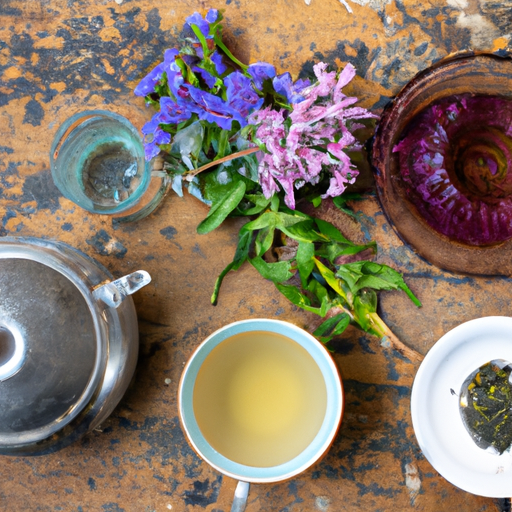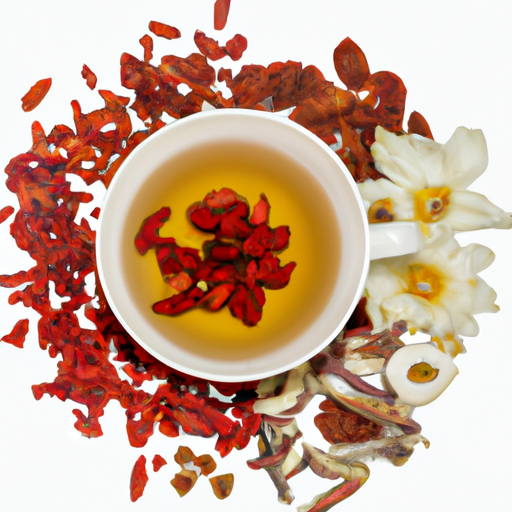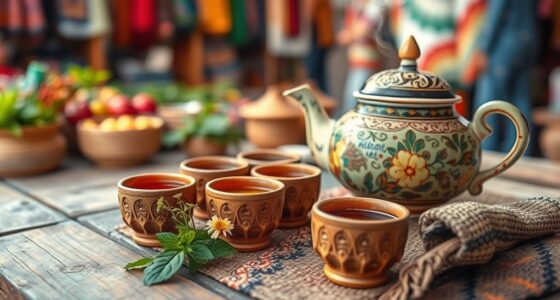Are you aware that the herbal tea industry is projected to reach a market value of $1.7 billion by 2026? Being a tea lover and business owner, I recognize the significance of determining the perfect price for your herbal tea blend.
Setting the right price is not only crucial for generating profits, but it also reflects the value you offer to your customers. In this article, I will guide you through the process of determining what you should charge for your herbal tea blend.
We will explore factors such as understanding your costs, researching the market, considering your target audience, and determining your profit margin. Additionally, we will discuss the importance of testing and adjusting your pricing strategy, as well as considering value-added options to enhance the perceived value of your tea blend.
By continuously evaluating and adapting your pricing strategy, you can ensure the success of your herbal tea business in this thriving industry.
Key Takeaways
- Understanding the costs involved in producing an herbal tea blend, including ingredients, packaging materials, labeling, branding, and overhead costs.
- Conducting thorough market research, including competitive analysis and analyzing pricing strategies, to determine the right price point for the herbal tea blend.
- Considering the target audience’s demographics, psychographics, and health concerns, and conducting surveys to gather insights for pricing decisions.
- Finding a balance between competitive pricing and sustainability, while also considering value-added options such as customized packaging and unique flavor combinations to justify a higher price point.
Understand Your Costs
You should know the expenses involved in creating your herbal tea blend before deciding on a price. It’s important to calculate expenses and conduct a price analysis in order to ensure that you are setting a fair and profitable price for your product.
Start by considering the cost of the ingredients used in your tea blend. This includes the herbs, spices, and other botanicals that you use. Research the market to find out the average price of these ingredients to get an idea of how much they will cost you.
In addition to the cost of ingredients, you should also factor in the cost of packaging materials, such as tea bags or tins, as well as any labeling or branding costs. Don’t forget to include any overhead costs, such as rent for your production space or utilities.
By understanding your costs, you can determine a price that not only covers your expenses but also allows for a reasonable profit margin.
Transitioning into the next section, it’s also important to research the market to see what similar herbal tea blends are priced at.
Research the Market
Get a pulse on the market by researching the competition and analyzing their pricing strategies, so you can come up with a price that stands out like a shooting star.
Conducting a competitive analysis will provide valuable insights into what other herbal tea blends are being offered and at what price point. Look for similar products and compare their ingredients, packaging, and branding to understand how they position themselves in the market. Additionally, take note of their pricing strategies, such as whether they offer discounts or promotions.
In addition to studying the competition, it’s crucial to consider consumer preferences. Look at what types of herbal tea blends are popular and what flavors or ingredients customers are seeking. Are there any specific health benefits that people are looking for in their herbal tea? Understanding these preferences will help you create a unique selling proposition for your blend.
By combining the insights gained from competitive analysis and understanding consumer preferences, you can determine a price that sets you apart from the competition while also meeting the demands of your target audience.
Transitioning into the next section, considering your target audience will allow you to tailor your herbal tea blend to their specific needs and preferences.
Consider Your Target Audience
Taking into account the tastes and desires of your potential customers will enable you to create a customized and irresistible herbal tea blend. To do this effectively, it is important to identify your target audience and understand their preferences. Conducting surveys and market research can provide valuable insights into what your customers are looking for in an herbal tea blend.
One way to identify your niche is to analyze the demographics and psychographics of your target market. Consider factors such as age, gender, lifestyle, and health concerns. For example, if your target audience is health-conscious individuals, you may want to focus on creating herbal tea blends that promote wellness and have specific health benefits.
In addition to demographics, conducting surveys can help you gather feedback on flavor preferences, packaging, and pricing. This will allow you to tailor your herbal tea blend to meet the needs and desires of your target audience.
To make the writing more interesting, here is a table that illustrates the different preferences and characteristics of potential customers:
| Preference | Characteristics |
|---|---|
| Floral | Elegant, feminine |
| Earthy | Natural, grounded |
| Fruity | Refreshing, sweet |
Considering the tastes and desires of your potential customers is crucial for creating an herbal tea blend that will attract them. By identifying your niche and conducting surveys, you can gain valuable insights into what your target audience is looking for. This will help you create a unique and appealing product that stands out in the market.
Transitioning into the subsequent section about determining your profit margin, it is important to consider the pricing aspect of your herbal tea blend.
Determine Your Profit Margin
When determining your profit margin for your herbal tea blend, it’s like finding the sweet spot on a balance scale where your costs and desired profit meet, creating a successful and sustainable business.
To set the right price for your herbal tea blend, you need to consider various pricing strategies and conduct a competitor analysis.
Firstly, you should assess your costs, including the ingredients, packaging, labor, and overhead expenses. This will help you determine the minimum price you need to charge to cover your costs and make a profit. Additionally, consider the perceived value of your product and what your target audience is willing to pay.
Next, conduct a competitor analysis to understand the pricing strategies used by other herbal tea brands. Look at similar products in the market and compare their prices, quality, and packaging. This will give you insights into what price range is competitive and reasonable for your herbal tea blend.
By analyzing your costs and conducting a competitor analysis, you can determine a profitable profit margin for your herbal tea blend. Remember, it’s essential to find a balance between competitive pricing and ensuring your business remains sustainable.
In the next section, we will discuss how to test and adjust your pricing strategy to optimize your profits.
Test and Adjust
Try experimenting with different pricing strategies and adjusting your approach to find the perfect balance that maximizes your profits while still attracting customers.
One way to do this is by experimenting with flavors. Offer different variations of your herbal tea blend and see which ones customers prefer. You can also ask for customer feedback to gather valuable insights on which flavors they enjoy the most. This will not only help you refine your product but also determine how much customers are willing to pay for it.
Testing and adjusting your pricing strategy is crucial because it allows you to find the optimal price point that maximizes your profits. Start by setting your initial price and monitor how customers respond. If you notice a high demand and positive feedback, you might consider raising the price slightly to increase your profit margin. On the other hand, if customers are hesitant to purchase or provide negative feedback, you might need to lower the price to attract more buyers.
Once you have experimented with flavors and gathered customer feedback, you can consider value-added options to further enhance your product. This could include offering additional benefits such as free shipping, discounts for bulk purchases, or complementary products that pair well with your herbal tea blend. By considering these value-added options, you can provide a more enticing offer to customers and increase the perceived value of your product.
Consider Value-Added Options
Adding value to your product can be a game-changer, enticing customers with irresistible offers and leaving your competitors green with envy.
When it comes to herbal tea blends, there are several value-added options that can elevate your product and justify a higher price point. One option is to offer customized packaging. This allows customers to personalize their tea blends, making it a unique and thoughtful gift option. Not only does customized packaging add a personal touch, but it also enhances the overall presentation, making your product stand out on the shelves.
Another way to add value to your herbal tea blends is by offering unique flavor combinations. Experiment with different herbs and spices to create innovative and delicious blends that customers won’t find anywhere else. Consider incorporating exotic ingredients or combining unexpected flavors to create a memorable tea experience. Highlight the health benefits of each ingredient to further entice customers.
By offering customized packaging and unique flavor combinations, you can position your herbal tea blends as a premium product, justifying a higher price point. However, it’s important to continuously evaluate and adapt your offerings based on customer feedback and market trends. This will ensure that you stay ahead of the competition and continue to meet the evolving preferences of your target audience.
Continuously Evaluate and Adapt
To stay ahead of the competition and ensure my herbal tea blend remains appealing to customers, it’s essential for me to continuously evaluate and adapt my offerings in response to market trends and customer feedback. By doing so, I can make informed decisions about pricing and value-added options that’ll keep my product competitive and relevant in the market.
To effectively evaluate feedback and analyze trends, I follow these steps:
-
Collect and analyze customer feedback: I actively seek feedback from my customers through surveys, reviews, and direct communication. This helps me understand their preferences, satisfaction levels, and any areas that may need improvement.
-
Monitor market trends: I keep a close eye on the herbal tea market, paying attention to emerging trends, new ingredients, and popular flavor profiles. This allows me to stay current and make adjustments to my blend if needed.
-
Adapt and innovate: Armed with customer feedback and market trends, I continuously adapt my herbal tea blend to meet changing demands. This may involve tweaking the recipe, introducing new flavors, or exploring unique packaging options.
By continuously evaluating feedback and analyzing trends, I can ensure that my herbal tea blend remains competitive, appealing, and in-demand among customers.
Frequently Asked Questions
How do I determine the quality of the herbal tea ingredients I should use?
Determining the quality of herbal tea ingredients is crucial. I source from trusted suppliers and conduct rigorous testing to ensure freshness and potency. Understanding herbal tea flavor profiles helps me create a harmonious blend. It’s an art, really.
What are the legal requirements for selling herbal tea blends?
To sell herbal tea blends, it is important to comply with legal requirements and labeling regulations. These regulations vary by country and state, so it’s crucial to research and understand the specific guidelines applicable to your location.
How can I effectively market my herbal tea blend to my target audience?
To effectively market my herbal tea blend to my target audience, I need to focus on effective branding and utilize social media advertising. By creating a strong brand identity and leveraging the power of social media, I can reach and engage with my ideal customers.
Are there any certifications or labels that can enhance the value of my herbal tea blend?
Certifications and labels can greatly enhance the value of your herbal tea blend. Look for certifications such as organic, fair trade, and non-GMO, as well as labels that highlight specific ingredients or health benefits. These credentials provide credibility and assurance to your target audience.
How can I differentiate my herbal tea blend from competitors in the market?
To differentiate my herbal tea blend from competitors, I focus on unique branding and differentiating factors. By creating a visually appealing packaging, highlighting the health benefits, and using high-quality ingredients, I stand out in the market.
Conclusion
In conclusion, pricing an herbal tea blend requires careful consideration of various factors. By understanding your costs, researching the market, and considering your target audience, you can determine a fair and competitive price.
It’s important to also factor in your desired profit margin and continuously evaluate and adapt your pricing strategy. Remember, finding the right price for your herbal tea blend is like finding the perfect balance between a refreshing sip and a soothing aroma – it’s an art that can elevate your business to new heights.
So, go ahead and steep your way to success!










